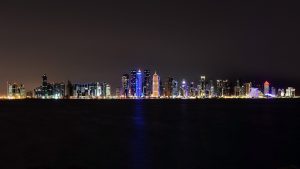By Alexandre Bohas
Translation: Pierre Chabal
Passage au crible n°63

Qatar. Baie de l’Ouest. Pixabay
Qatar regularly features high in newspaper headlines for its acquisition of works of art. The reining family, aware of the limited resources of their territory, has invested abroad. This paper seeks to understand this involvement in the field of art, reputed uncertain and unproductive.
> Historical background
> Theoretical framework
> Analysis
> References
In tune with the increase in hydrocarbon prices and the financial crisis, Qatar’s micro-monarchy has been proceeding with several investments in various strongholds of the world economy. It already owns luxurious touristic institutions such as the Carlton, the Royal Monceau, Harrods and the Savoy Hotels. It holds also minority participations in French multinationals: Vinci, Lagardère, Vivendi, Total, LVMH, Suez Environnement, as well as in European ones: Volkswagen, Porsche or Barclays.
Beside these assets, the Qatari monarchy is also buying masterpieces by famous painters. In 2011, it ranked 1st in the list of the greatest investors on the art market. One estimates that, in just seven years, US exports to Qatar represent US$ 428 million. For instance, in 2009, the Emirate bought the Rothko of Ezra Merkin, the financer, for US$ 310 million, only two years after buying those of the Rockfeller collection. Similarly, Qatar acquired for € 45 million Euros the Claude Berri Fund, originally destined to France. And, in order to exhibit these works of art, Qatar calls upon the greatest, internationally-recognized architects. The Qatari National Museum was thus designed by Jean Nouvel ; the Museum of Islamic Art, inaugurated in 2008, was designed by the Sino-American Pei ; and the Museum of Modern Art by Jean-François Bodin.
The anarchical society of the international. Although anarchy characterizes the international sphere, such a situation can take on various forms and is, to be sure, shaped by ideological and material factors, so that it is rather akin to an « international society » (Hedley Bull) than to the perpetual war depicted by the realists. Its members are drawn to entertain cooperative relations, to participate in institutions and to internalize common values, such as loyalty and mutual recognition.
The paradoxical power of small states. While these are often neglected by internationalists, theories relevant for them tend to restrict them to diplomacies aimed at the promotion of norms, of peace and of humanitarian operations (Christine Ingebritsen). Yet, in the recent years, there has been a relative decline of great powers and a contrario, the « Lilliputian States » (Robert Keohane) seem to have benefited from a globalization marked by an intensification of relations as well as from a surge of transnational actors. In such a dynamic, several of them seems to be at the outposts as they concentrate huge amounts of capital and as they position themselves as unavoidable nexi of financial, cultural, commercial and human flows.
Taking advantage of the rapid mutations of capitalism and of the world order, Katzenstein’s observations as to the adaptation and the resistance of small States are being confirmed. In effect, globalization has intensified inter-sectoral competition, causes the formation of “économies-monde” as well as the concentration of riches. Thus, power no longer supposes simply the control of the productive and distributive capacities that ensure the independence, if not the autonomy, of Nation-States. Conversely, power is rather derived from the authority and the radiance resulting from the possession of one or several of these nexi of global attraction. In other words, the logic consists not in withdrawing oneself from the international game but on the contrary to find in it a position of prime relevance. For instance, if the United States today keep up nowadays a structural preponderance, this is due also to the central position of Hollywood in the cinema industry, or Wall Street in the world finance, or the Silicon Valley in the new technologies of information and communication.
In a world today having become fragmented and organized in archipelagos, small-sized countries are prompt to polarize around a specific field. This is why some of them, like Qatar, are experiencing a spectacular development. Similarly to Singapore or even to tax heavens, Qatar seeks now to specialize in the world of knowledge and fine arts. These sectors are to enable the country to reach world recognition as a protective rampart against threatening neighbors such as Saudi Arabia or Iran; and they are to contribute to the development of a territory that derives the better part of its resources from the gas industry. Let us remind ourselves that Qatar launched in 1996 the world-famous television channel Al-Jazira, which has since imposed itself in and onto the audiovisual landscape. The kingdom then went on to welcoming artists seeking asylum from Iraq, while its leaders are proving great collectors of art. Moreover, it has attracted several universities, such as the American Georgetown, Northwestern, Carnegie and Cornell, or the European from Stenden and Canadians from Calgary and North Atlantic, who have settled and developed complete curricula in the country. This strategy resembles that of Abu Dhabi, a state which embarked upon the construction of branches for the Le Louvre and the Guggenheim museums not long after inaugurating campuses of Paris-Sorbonne, HEC and New York universities, even one for the Beirut Saint Joseph University.
All in all, this policy of cultural grandeur demonstrates rather well that power cannot equated solely with capacities and geostrategic resources but results pointedly from world transformations which create opportunities for certain, hitherto neglected, actors. Enjoying an autonomous form of government and formally sovereign – in accordance with their statist character – these attract non-state organizations, such as economic firms, in order to form themselves into attractive centers within globalization.
« A Smithsonian in the Sand », The Economist, 29 Dec. 2010.
Barthe Benjamin, « Qatar. Les ambitions démesurées d’une micro-monarchie », Le Monde, 25 fév. 2012, pp. 4-5. Supplément Géo et Politique.
Bull Hedley, The Anarchical Society. A Study of Order in World Politics, New-York, Columbia University Press, 1977.
« Ce que le Qatar possède en Europe », Challenges, 14 fév. 2012.
Elkamel Sara, « Qatar Becomes World’s Biggest Buyer of Contemporary Art », The Guardian, 13 July 2011.
Hartvig Nicolai, « Qatar Looks to Balance Its Arts Scene », New York Times, 6 Jan. 2012.
Ingebritsen Christine, “Norm Entrepreneurs: Scandinavia’s Role in World Politics”, Cooperation and Conflict, 1 (37), 2002, pp. 11-23.
Katzenstein Peter J., Small States in World Market: Industrial Policy in Europe, Ithaca, Cornell University Press, 1985.
Katzenstein Peter J., « Small States and Small States Revisited », New Political Economy, 8 (1), 2003.
Keohane Robert O., « Lilliputians’ Dilemmas: Small States in International Politics », International Organization, 2 (23), Spring 1969, pp. 291-310.
Laroche Josepha (Éd.), La Loyauté dans les relations internationales, 2e éd., Paris, Harmattan, 2011.
Le Grand Dominique , « Le Qatar, premier acheteur d’art », Le Soir, 2 août 2011.
Waage Hilde Henriksen, « The ‘Minnow’ and the ‘Whale’: Norway and the United States in the Peace Process in the Middle East », British Journal of Middle Eastern Studies, 34 (2), Aug. 2007, pp. 157-176.




